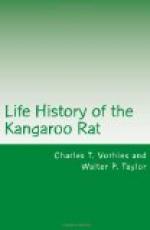Less regularly present, perhaps because of its different life history, is a small tick, Trombicula sp. At times this parasite is very common, being present on nearly every individual rat, and at other times specimens are difficult to find; it appears to be more commonly present in summer and fall than at other seasons, and is found attached chiefly to the ears.
No internal parasites have been detected. The nocturnal and fossorial habits of the animal seem to give complete protection against a form of parasite which is very common among some other rodents of the Range Reserve, notably Lepus and Sylvilagus. Nearly all rabbits are infested with “warbles,” the larvae of a species of bot-fly, Cuterebra (family Oestridae). Other small mammals also are occasionally parasitized by the Cuterebra, but in the handling and examination of perhaps 200 or more individuals of spectabilis and merriami, we have yet to find a single case of infestation by an oestrid fly.
ABUNDANCE.
One’s first impression of a well-occupied spectabilis area is that a large family must inhabit each den, but, as previously mentioned, we have gradually been compelled to shift from this conception to the idea of but a single animal to a mound, except when the young are present. Therefore a census of the adult kangaroo rat population can readily be made, simply by counting the mounds. Such a census affords at least a conservative estimate of the number of adult individuals occupying a given area.
The first estimates of abundance on the Range Reserve were from actual counts of dens on areas measured off for experimental fencing, and gave the figure of about two mounds to the acre. From time to time rough estimates were made on different portions of the pastures, and these checked well with the above. Later still, a careful count showed 300 mounds on approximately 160 acres (see p. 8), or 1.87 mounds per acre. Nine areas of 2 acres each, representing different environmental conditions, were later selected in different portions of the Range Reserve, and the dens accurately counted. The number of dens per 2 acres varied from none to a maximum infestation of 12, neither extreme occurring over large areas. The total number of dens was found to be 43 on the 18 acres, or an average of 2.38 dens per acre.
From all these estimates it may fairly be concluded that two mounds, or two animals, per acre is a conservative estimate for the infestation of the entire Range Reserve, with the possible exception of small areas at its upper edges, where the altitude limit of spectabilis is passed. It is, however, impossible to estimate the area of the State infested with kangaroo rats, for some large stretches of fine grassland show no kangaroo rats whatever, while others have more than are present on the reserve; and we have no estimates of the extent of either type.




